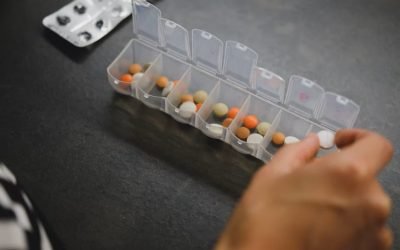Last updated: November, 2025
Pain changes how we live. It limits, isolates, and slowly reshapes daily life. For many, oxycodone becomes a trusted solution: a prescription that promises relief and a return to normality. Yet, what begins as a medical necessity can sometimes grow into dependence.
Understanding oxycodone addiction means understanding how the body adapts, how tolerance develops, and how recovery, when guided with compassion and clinical care, can restore balance. At Hacienda Paradiso Rehab in Spain, that recovery unfolds in safety, dignity, and calm.
What Is Oxycodone And How It Works
Oxycodone is a strong opioid painkiller prescribed for moderate to severe pain. Doctors often recommend it after major surgery, injury, or during chronic illness. It offers relief when other painkillers are not enough, but it also interacts with the brain’s reward system, which can lead to physical and emotional dependence.
Medical Use And Purpose
Oxycodone is widely used in modern medicine as part of pain management and recovery. It may be taken in short-acting or extended-release forms, depending on the patient’s condition. When used responsibly and with regular medical review, it can be both effective and safe. The problem arises when tolerance grows, and the same dose no longer provides relief.
This slow shift is often where oxycodone dependence begins, not from misuse, but from the body’s adaptation to the medication. Recognising it early allows for careful oxycodone detox and a gradual, supervised approach to recovery.
How Oxycodone Affects The Brain And Body
Like other opioids, oxycodone binds to pain receptors in the brain, altering how the body perceives discomfort. It also triggers dopamine release, the chemical responsible for feelings of calm and satisfaction. Over time, the brain begins to associate the drug with relief and safety.
This process is why oxycodone addiction can develop even when the medication is prescribed. The body craves balance, and when the drug is absent, withdrawal follows: a cycle that can only be broken with structured oxycodone treatment and emotional support.
The Risks Of Oxycodone Use
Oxycodone’s power lies in its ability to relieve pain quickly, but that same power carries risks. Understanding these risks helps prevent harm and guides safer use.
Physical And Psychological Risks
Common side effects include drowsiness, nausea, constipation, and confusion. Long-term use may lead to poor sleep, low mood, and loss of motivation. The mind begins to rely on the drug to cope with stress and discomfort, creating both physical and emotional dependence.
These risks highlight why oxycodone treatment should always be supervised and reviewed by medical professionals.
Dangerous Combinations And Interactions
Combining oxycodone with alcohol, benzodiazepines, or recreational drugs can be fatal. Even grapefruit juice affects how the liver processes the medication, increasing its potency and side effects. Safety depends on openness, always informing doctors of all medications or supplements in use.
Oxycodone Overdose And Emergency Risks
Overdose occurs when breathing slows or stops completely. Confusion, blue lips, and loss of consciousness are warning signs that require immediate help. Preventing overdose begins with awareness and honesty, never altering a prescribed dose without medical supervision.
Understanding Dependence And Addiction
Oxycodone dependence develops gradually. It does not reflect failure or weakness; it reflects the body’s adjustment to a powerful drug. Recognising the signs early can make the difference between quiet suffering and safe recovery.
How Dependence Develops
As tolerance builds, the body demands more to achieve the same effect. Relief becomes harder to reach, and withdrawal appears sooner. The brain’s chemistry changes and so does mood, focus, and energy. This is why medical guidance is essential when learning how to stop taking oxycodone safely.
Signs Of Addiction
Physical symptoms include restlessness, insomnia, and anxiety. Emotional signs can be guilt, irritability, and withdrawal from loved ones. Behaviourally, people may take extra doses or think constantly about medication. These signs are messages from the body, not reasons for shame. They signal a need for professional oxycodone rehab and compassionate care.
The Emotional Cycle Of Dependence
Addiction traps many people in a cycle of relief and regret: seeking peace through the same source that causes distress. Therapy helps break this cycle by replacing fear with understanding and guilt with acceptance. Healing begins with being heard and supported through structured oxycodone treatment that addresses both mind and body.
Oxycodone Withdrawal And Detoxification
When oxycodone use stops, the body begins to readjust. The process is called withdrawal: and though it can be uncomfortable, it is also the first step toward healing. A supervised oxycodone detox provides comfort, structure, and safety throughout this stage.
Symptoms Of Oxycodone Withdrawal
Common symptoms of oxycodone withdrawal include sweating, shaking, nausea, muscle pain, and anxiety. Sleep disturbances, mood swings, and fatigue are also frequent. These symptoms usually begin within 24 to 72 hours of the last dose and gradually fade after a week. In professional care, medication and therapy help ease this transition.
How To Stop Taking Oxycodone Safely
Stopping oxycodone should never be abrupt. A gradual reduction plan (or tapering) helps the body adjust naturally. Medical teams monitor vital signs, adjust doses, and provide emotional support throughout. This approach minimises discomfort and drastically lowers relapse risk, making detox safer and more humane.
The Role Of Supervised Detox
At Hacienda Paradiso Rehab in Málaga, supervised detox means continuous care. Doctors, nurses, and therapists collaborate to manage withdrawal and promote calm. The goal is not only to cleanse the body but to restore trust: in oneself, in the body’s ability to recover, and in the process of healing.
Treatment And Recovery
Recovery from oxycodone addiction requires more than medical detox; it requires a holistic plan that supports the whole person (physically, emotionally, and spiritually). At Hacienda Paradiso, every treatment plan is designed to honour individuality, privacy, and dignity.
Medical Detox And Continuous Monitoring
Each client begins with a full assessment and a personalised plan for detoxification. Vital signs are monitored daily, and medication is carefully adjusted to manage discomfort. Continuous supervision ensures safety and stability during the most vulnerable moments of withdrawal.
Therapy And Emotional Healing
Therapy is where recovery deepens. It addresses trauma, stress, and emotional pain that may have contributed to oxycodone addiction. Through one-to-one counselling, group sessions, and mindfulness practices, clients learn new ways to manage pain — without the need for medication.
Holistic And Eco-Friendly Recovery
Healing at Hacienda Paradiso extends beyond the medical. Nutrition, movement, and nature-based therapies form part of daily life. The eco-friendly rehab setting helps regulate the nervous system and promotes balance. This philosophy of sustainable healing allows recovery to become not only achievable but natural.
Healing In Nature: Treatment For Oxycodone Addiction In Spain
In southern Spain, surrounded by light and silence, Hacienda Paradiso offers a safe space for those seeking treatment for oxycodone addiction in Málaga. Here, nature is not decoration: it is therapy. The rhythm of the environment supports rest, reflection, and gentle recovery.
The Environment: Calm, Privacy, And Safety
Set among olive groves and open skies, the setting invites calm. Privacy is protected at every step, allowing individuals to heal with dignity. The natural surroundings support the emotional and physiological regulation needed during oxycodone rehab.
A Compassionate And Professional Team
The team at Hacienda Paradiso blends medical precision with human empathy. Each resident receives constant guidance from doctors, therapists, and nurses who understand addiction and recovery on every level. Every person is treated as an individual, never as a case.
Sustainable Healing Beyond Detox
Recovery extends far beyond the walls of the clinic. Through aftercare and relapse prevention, clients learn to maintain emotional balance and physical wellbeing after discharge. Ongoing contact with therapists ensures that the healing achieved here continues at home; steady, confident, and sustained.
Taking The First Step With Hacienda Paradiso
Frequently Asked Questions: Oxycodone Addiction
Oxycodone addiction happens when the body and mind begin to rely on this strong pain-killer to function as usual. It can develop even under correct prescription, because over time tolerance rises and the drug starts being needed for more than pain relief. Recognising it early allows for safe treatment and detox.
Many people experience sweating, restlessness, nausea, insomnia, muscle aches and anxiety when reducing or stopping oxycodone. These withdrawal symptoms usually begin 24–72 hours after last use and can last about a week. Medical supervision makes the process gentler and safer.
The safest approach to stop oxycodone is a medically supervised tapering plan: reducing the dose gradually under professional care. Stopping suddenly increases risk of severe withdrawal and relapse. A structured detox and ongoing support help maintain long-term recovery.
Yes. Oxycodone addiction can be treated effectively through a comprehensive plan combining medical detox, therapy and holistic support. With the right guidance, individuals can regain stability, rebuild their emotional wellbeing and live beyond dependence.
Spain offers a calm, supportive environment for recovery. Centres in Málaga specialise in treatment for oxycodone dependence, combining medical expertise with beautiful natural surroundings. This setting fosters healing, privacy and dignity during recovery.








